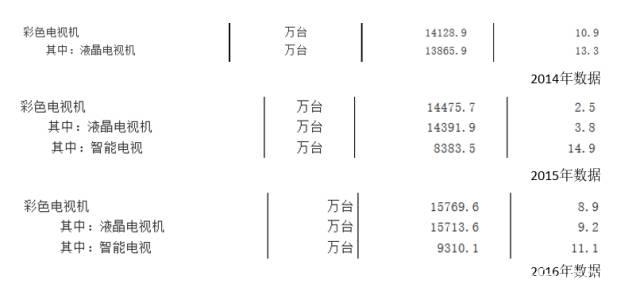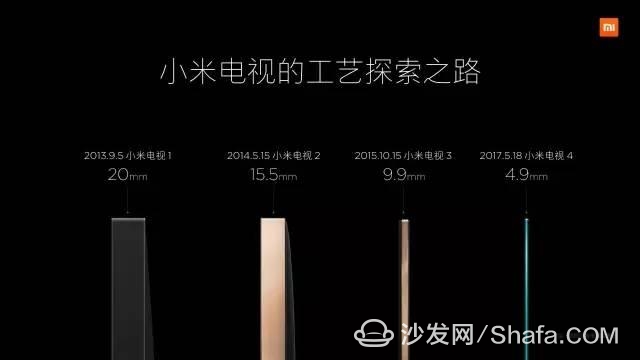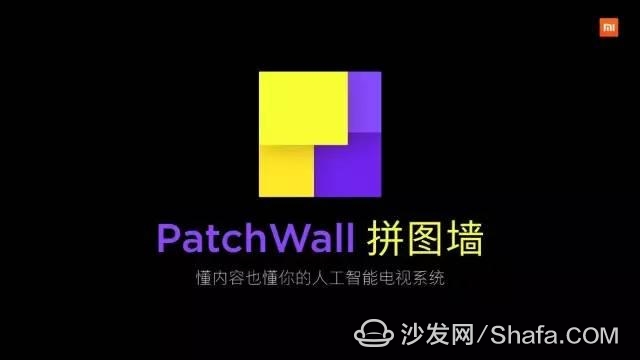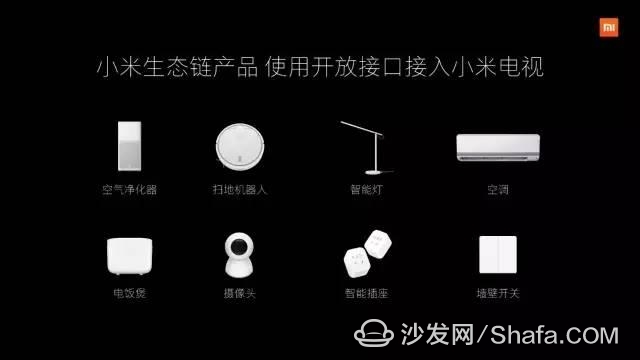According to the "Statistical Communique on National Economic and Social Development" released by the National Bureau of Statistics, from 2014 to 2016, the country's smart TV production volume has maintained a growth of over 10%, and the growth rate has exceeded the growth rate of color TV sets. (Smart TVs were not counted separately in 2013.)

The development of smart TVs has been accompanied by the continuous entry of new Internet brands and the continuous updating of established TV manufacturers. Many changes have taken place from the hardware form to the software ecosystem. This article will use Xiaomi TV as a sample, focusing on the development of smart TV and analyzing its future development trend.
Xiaomi released the first smart television product, Xiaomi TV1, in September 2013. Afterwards, it released a number of smart TV products. From the evolution of Xiaomi TV, we can see the changes in the entire smart TV industry and pry into smart TVs. Future trends.
Millet TV Development History
September 2013 Millet TV 1 released May 2014 Millet TV 2 released July 2015 Millet TV 2S released October 2015 Millet TV 3 released September 2016 Millet TV 3S released March 2017 Millet TV 4A Series released 2017 May millet TV 4 released
The biggest change is the "value"
In recent years, we can see the technological exploration of smart TV brands in screen technology, audio technology, etc. However, the most obvious and most significant change in smart TVs is appearance.
Paying attention to appearance is not a smart TV brand's "wishful thinking." According to the "China TV Market Summary Report for the First Quarter of 2017" jointly released by the China Electronics Video Industry Association and Ovid Cloud Network, appearance is the highest demand for consumer TVs, exceeding quality, system, sound quality, and content. And other needs. Consumers' attention to appearance indicates that the demand for smart TVs is “more beautiful†than “usefulâ€.
Smart TV products have made many attempts in appearance, of which the thickness of smart TV products is more typical. Taking Xiaomi as an example, the millet TV 1 introduced in 2013 has a thickness of 20mm. The thickness of the millet TV 3S introduced in 2016 is 5.9mm, and the thickness of the recently launched millet TV 4 is only 4.9mm. (The data here is the thinnest point of the smart TV.) In addition to directly improving the “face valueâ€, the thinning of the smart TV can also provide more possibilities for home improvement.

In addition to thinning, smart TVs have also made many attempts in terms of television materials, frame design, and so on. For example, the emergence of curved screen smart TVs. Curved screen arcs more in line with modern aesthetics, giving a better wrap-around look. Xiaomi has launched the millet TV 3S 65 inch curved screen smart TV.
Increased access to content
The important difference between smart TV and traditional TV is content. Smart TVs rely on Internet resources to provide users with a large amount of quality video content. When Smart TV was just launched, the main way to obtain content was to collaborate with video sites to customize content. At that time, video sites had a large amount of video resources that could meet the user's demand for content.
With the annual increase in video copyright purchase fees and the intensified content competition of video websites, video website content has become more difficult to obtain. It is difficult for a single video website to cover popular video content. For example, in the TV drama “The People's Name†that was broadcast shortly before, the right to play online was won by some video sites. This means that smart TVs that are cooperating with other video sites cannot directly launch these content.

From the development history of Xiaomi TV, Xiaomi insists on “opening up†in content acquisition, and cooperates with a number of video websites to form a video alliance to obtain more content.
The "closed" construction of its own content and "openness" cooperation with the content platform is a smart TV brand that needs to be selected in the content acquisition approach. However, as the difficulty of obtaining content increases, the difficulty of smart TV brands choosing to “close†their own content will increase year by year.
Artificial intelligence gradually becomes the standard for smart TVs
In the development of smart TVs, consumers are often questioned as "not smart enough." The difference from traditional television is mainly reflected in the ability to connect to the Internet. With the continuous development of artificial intelligence technology, more and more smart TV products have now joined the artificial intelligence module. Millet TV 4A started with the Xiaomi brain intelligent voice system.
On the whole, the application of artificial intelligence in smart TV products is still relatively preliminary and has not yet reached the full expectations of consumers for "smart". However, artificial intelligence has the advantage of being able to learn and grow on a daily basis, and to enhance its capabilities through the collection and accumulation of data. I believe that thanks to the further optimization of deep learning algorithms, artificial intelligence will make smart TVs more and more intelligent.
At present, the application of artificial intelligence on television is mainly based on intelligent voice and content recommendation. Smart voice can provide a more convenient way of interaction. Content recommendation is to analyze the user's usage habits, deeply learn user habits, and recommend user-interested content.

Millet artificial intelligence development process
1. In August 2015, the MIUI7 conference released a baby album based on face recognition technology. 2. In August 2016, the new algorithm developed by Xiaomi's face detection algorithm team ranked first on the FDDB face detection accuracy rate. 3. March 2017. The launch of the millet TV 4A series, starting with the millet TV PatchWall artificial intelligence voice system 4. In May 2017, millet artificial intelligence open platform - water droplets platform released, millet open to artificial intelligence technology services for developers.
The future of smart TV may be smart home center
The emergence of a large number of smart hardware products has led to the development of smart homes. At present, the interaction center of smart homes is focused on mobile phones. We need to manage various smart home devices through mobile phones. However, there are many scenes in the home life. Controlling all smart home devices only through the mobile phone can make the operation very cumbersome.
Smart homes do not need to be limited to one center, but can have multiple centers. The multi-center approach can improve the management efficiency of smart devices, especially when many mobile phones are not around. For example, we can use smart TVs to manage other smart devices while watching TV.
As one of the centers of home life, Smart TVs connect other smart devices to smart TVs, which undoubtedly makes smart TVs more useful.
Millet TV is trying this way. Xiaomi launched the “Water Drops Plan†to allow access to smart home devices. At present, there are 8 products such as air purifiers, sweeping robots, smart lights, air conditioners, rice cookers, cameras, smart sockets, and wall switches that access millet TVs.

With the continuous improvement of artificial intelligence technology and the increase of external smart devices, there are more possibilities for the future of smart TVs.
Smart TV/box information can focus on smart TV information network sofa butler (http://), China's influential TV box and smart TV website, providing information, communication, etc. on TV boxes, smart TVs, smart TV software, etc. Answering questions.

Xiaomi released the first smart television product, Xiaomi TV1, in September 2013. Afterwards, it released a number of smart TV products. From the evolution of Xiaomi TV, we can see the changes in the entire smart TV industry and pry into smart TVs. Future trends.
Millet TV Development History
September 2013 Millet TV 1 released May 2014 Millet TV 2 released July 2015 Millet TV 2S released October 2015 Millet TV 3 released September 2016 Millet TV 3S released March 2017 Millet TV 4A Series released 2017 May millet TV 4 released
The biggest change is the "value"
In recent years, we can see the technological exploration of smart TV brands in screen technology, audio technology, etc. However, the most obvious and most significant change in smart TVs is appearance.
Paying attention to appearance is not a smart TV brand's "wishful thinking." According to the "China TV Market Summary Report for the First Quarter of 2017" jointly released by the China Electronics Video Industry Association and Ovid Cloud Network, appearance is the highest demand for consumer TVs, exceeding quality, system, sound quality, and content. And other needs. Consumers' attention to appearance indicates that the demand for smart TVs is “more beautiful†than “usefulâ€.
Smart TV products have made many attempts in appearance, of which the thickness of smart TV products is more typical. Taking Xiaomi as an example, the millet TV 1 introduced in 2013 has a thickness of 20mm. The thickness of the millet TV 3S introduced in 2016 is 5.9mm, and the thickness of the recently launched millet TV 4 is only 4.9mm. (The data here is the thinnest point of the smart TV.) In addition to directly improving the “face valueâ€, the thinning of the smart TV can also provide more possibilities for home improvement.

Increased access to content
The important difference between smart TV and traditional TV is content. Smart TVs rely on Internet resources to provide users with a large amount of quality video content. When Smart TV was just launched, the main way to obtain content was to collaborate with video sites to customize content. At that time, video sites had a large amount of video resources that could meet the user's demand for content.
With the annual increase in video copyright purchase fees and the intensified content competition of video websites, video website content has become more difficult to obtain. It is difficult for a single video website to cover popular video content. For example, in the TV drama “The People's Name†that was broadcast shortly before, the right to play online was won by some video sites. This means that smart TVs that are cooperating with other video sites cannot directly launch these content.

The "closed" construction of its own content and "openness" cooperation with the content platform is a smart TV brand that needs to be selected in the content acquisition approach. However, as the difficulty of obtaining content increases, the difficulty of smart TV brands choosing to “close†their own content will increase year by year.
Artificial intelligence gradually becomes the standard for smart TVs
In the development of smart TVs, consumers are often questioned as "not smart enough." The difference from traditional television is mainly reflected in the ability to connect to the Internet. With the continuous development of artificial intelligence technology, more and more smart TV products have now joined the artificial intelligence module. Millet TV 4A started with the Xiaomi brain intelligent voice system.
On the whole, the application of artificial intelligence in smart TV products is still relatively preliminary and has not yet reached the full expectations of consumers for "smart". However, artificial intelligence has the advantage of being able to learn and grow on a daily basis, and to enhance its capabilities through the collection and accumulation of data. I believe that thanks to the further optimization of deep learning algorithms, artificial intelligence will make smart TVs more and more intelligent.
At present, the application of artificial intelligence on television is mainly based on intelligent voice and content recommendation. Smart voice can provide a more convenient way of interaction. Content recommendation is to analyze the user's usage habits, deeply learn user habits, and recommend user-interested content.

1. In August 2015, the MIUI7 conference released a baby album based on face recognition technology. 2. In August 2016, the new algorithm developed by Xiaomi's face detection algorithm team ranked first on the FDDB face detection accuracy rate. 3. March 2017. The launch of the millet TV 4A series, starting with the millet TV PatchWall artificial intelligence voice system 4. In May 2017, millet artificial intelligence open platform - water droplets platform released, millet open to artificial intelligence technology services for developers.
The future of smart TV may be smart home center
The emergence of a large number of smart hardware products has led to the development of smart homes. At present, the interaction center of smart homes is focused on mobile phones. We need to manage various smart home devices through mobile phones. However, there are many scenes in the home life. Controlling all smart home devices only through the mobile phone can make the operation very cumbersome.
Smart homes do not need to be limited to one center, but can have multiple centers. The multi-center approach can improve the management efficiency of smart devices, especially when many mobile phones are not around. For example, we can use smart TVs to manage other smart devices while watching TV.
As one of the centers of home life, Smart TVs connect other smart devices to smart TVs, which undoubtedly makes smart TVs more useful.
Millet TV is trying this way. Xiaomi launched the “Water Drops Plan†to allow access to smart home devices. At present, there are 8 products such as air purifiers, sweeping robots, smart lights, air conditioners, rice cookers, cameras, smart sockets, and wall switches that access millet TVs.

Smart TV/box information can focus on smart TV information network sofa butler (http://), China's influential TV box and smart TV website, providing information, communication, etc. on TV boxes, smart TVs, smart TV software, etc. Answering questions.
The main pain points in obtaining customers in foreign trade are fierce market competition, high customer acquisition costs, low customer stickiness, and single marketing methods. With the changes in the market environment, traditional marketing methods have been unable to meet customer needs. Enterprises need innovative marketing methods and technical means to improve customer stickiness and loyalty, reduce customer acquisition costs, in order to obtain more business opportunities in the fierce market competition.
Car Seat
Guangdong ganzhou , https://www.cn-gangdao.com
